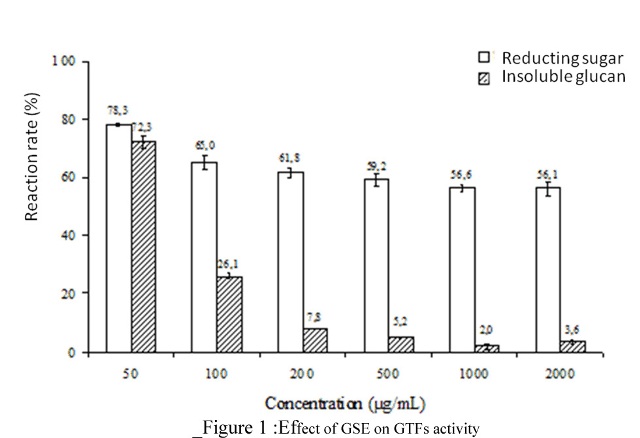ABSTRACT: 0716
Effect of a Grape Seed Extract on GTFs activity
| M.-C. BADET, U.F.R. of Odontology, Bordeaux Cedex, France, A. FURIGA, University Victor SegalenBordeaux2, France, M. DOLS-LAFARGUE, University Victor Segalen Bordeaux2, Talence, France, and A. LONVAUD-FUNEL, University Victor SegalenBordeaux2, Talence, France | |
Objectives: An interesting mean of controlling the accumulation of dental plaque would be to inhibit the functions of streptococcal glucosyltransferases and in particular the insoluble glucan (ISG) production The aim of this study was first to characterize a representative GTF preparation from S.sobrinus ATCC 33478 and then to evaluate the effects of a Grape Seed Extract on insoluble glucan formation by combined GTFs. Method: The purity of the crude GTF mixture was assessed by electrophoresis analysis. The effect on GTF activity was determined by measuring the amount of reducing sugars by dinitrosalicylic acid assay, with fructose as a standard. The effects of pH, temperature, sucrose and dextran T10 concentrations on GTF activity were analyzed and the chemical structure of the products investigated. To determine the amount of insoluble glucan synthesized, the heated samples were weighed after centrifugation, three washes and drying. The GTF inhibition was analyzed through the reductions in the overall reaction rate and the quantity of ISG synthesized. Results: The S.sobrinus ATCC 33478 crude GTF preparation obtained contains a mixture of the four different GTF known for this species. For optimal adherent ISG formation, the reaction parameters were 37°C, pH 6.5, sucrose 50 g/l and dextran T10 2 g/L. The effects of GSE at different concentrations are shown figure 1. Conclusion: At the concentration of 1000 µg/ml, GSE shows a reduction of the quantity of ISG synthesized of 98%. This polyphenolic compound could be helpful as chemical anti plaque agent, that could prevent oral biofilm formation without affecting the biological equilibrium within the oral cavity. This work was supported by the Laboratoire Pierre Fabre
| |
| Seq #93 - Streptococci A 2:00 PM-3:15 PM, Thursday, July 3, 2008 Metro Toronto Convention Centre Exhibit Hall D-E | |
|
Back to the Microbiology / Immunology and Infection Control Program | |
©Copyright 2008 American Association for Dental Research. All Rights Reserved.
